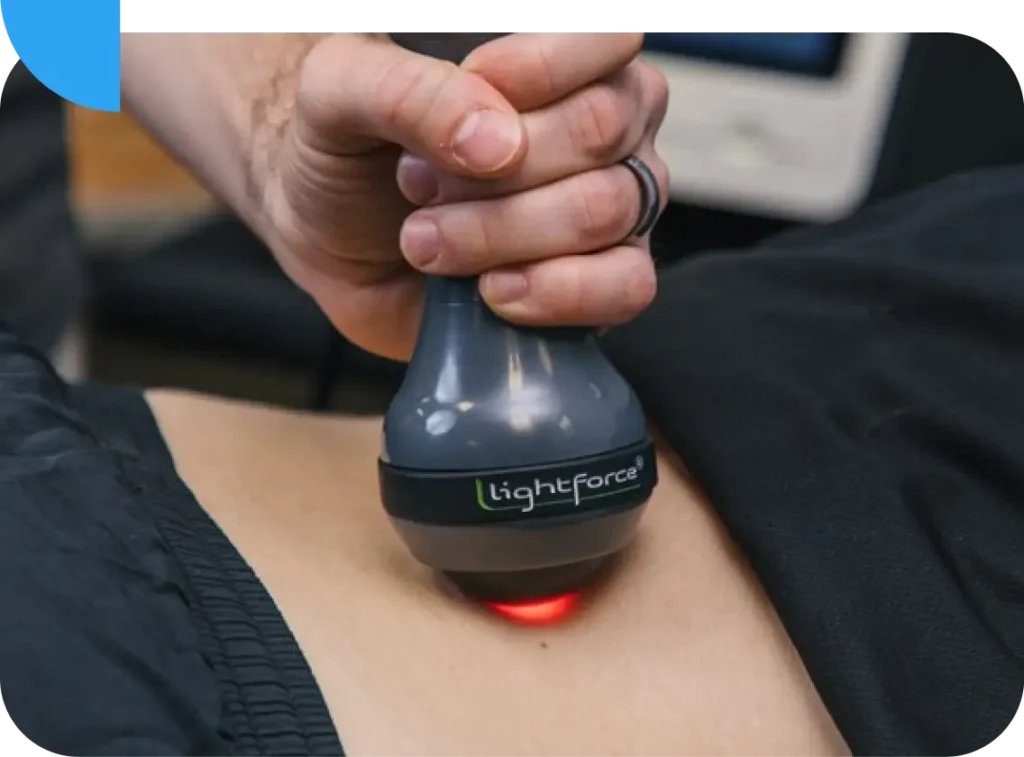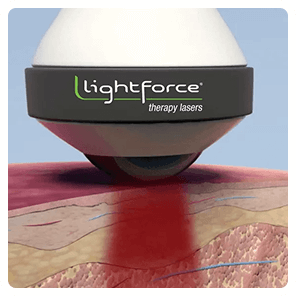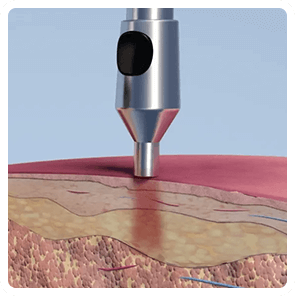A safe and effective therapy supports faster recovery and long-lasting relief, making it a valuable option for patients dealing with both acute and chronic conditions.
Laser therapy is an FDA-approved, non-invasive treatment designed to relieve persistent pain and support healing. By using focused light to stimulate cellular activity, it improves circulation, reduces inflammation, eases muscle spasms, and boosts recovery. At Comprehensive Spine Center of Dallas, we now offer deep tissue laser therapy as part of personalized treatment plans. Schedule an appointment today to see if this therapy is right for you.
Laser therapy is used to treat acute and chronic conditions as well as post-activity recovery.
It is also used as another option to prescription drugs, a tool to prolong the need for some
surgeries, as well as pre and post- surgery treatment to help control pain and swelling.
Therapy lasers for acute conditions are particularly effective when administered as soon as the injury has occurred (assuming there is no active hemorrhaging). Bringing pain under control quickly helps the healing process and usually helps promote better outcomes.
With chronic conditions, research has shown that therapy lasers can be used to help combat persistent pain and promote circulation to damaged tissues. It can be a powerful, non- pharmaceutical solution to reduce pain without the side effects of medication.
Laser Therapy can be found on the sidelines of many pro, college, and Olympic sports teams across the United States and many parts of Europe and Asia. Laser therapy has been shown to improve post-activity recovery times and reduce delayed onset muscle soreness (DOMS).

Our therapy lasers have useful applications in treating the following painful conditions:
Specific wavelengths of light penetrate deep into tissue to target the source of pain.
Advanced equipment ensures more light enters the body without scattering.
By avoiding unwanted absorption, light energy reaches the cells that need it most.
The right power level ensures enough light stimulates healing for effective results.
Comprehensive Spine Center uses advanced Class IV Laser technology for deep tissue therapy. Its higher wattage delivers faster treatments, reaching deeper structures and providing results not possible with low-power lasers—ensuring effective, lasting pain relief.

Class IV Laser (High Intensity)

Class IIIb Laser (Low Level)
“THE EFFECT OF HIGH-INTENSITY VERSUS LOW-LEVEL LASER THERAPY IN THE MANAGEMENT OF PLANTAR FASCIITIS: A RANDOMIZED CLINICAL TRIAL”
We aimed to compare the efficacy of low-level laser therapy (LLLT) and high-intensity laser therapy (HILT) in the treatment of plantar fasciitis (PF). Seventy patients were randomized into either the LLLT (8 men, 27 women; mean age 48.65 ± 10.81 years) or HILT (7 men, 28 women; mean age 48.73 ± 11.41 years) groups. LLLT (904 nm) and HILT (1064 nm) were performed three times per week, over a period of 3 weeks. Each treatment combined with silicone insole and stretching exercises.
Three weeks later, both groups showed significant improvement in all parameters (p < 0.05). The HILT group demonstrated better improvement in all parameters than the LLLT group. Although both treatments improved the pain levels, function, and quality of life in patients with PF, HILT had a more significant effect than LLLT.”
Published: Lasers in Medical Science, 2018 Aug;33(6):1363-1369.



Request Your Same-Day Laser Therapy Evaluation
Don’t wait in pain — our expert spine specialists are available for same-day evaluations.
Laser therapy is an FDA-approved, noninvasive treatment that uses light energy to help reduce persistent pain. It stimulates cells in the body to trigger natural healing processes. The therapy improves microcirculation, decreases inflammation, reduces muscle spasms, and increases cellular metabolism. At our clinic, deep tissue laser therapy is used as part of a personalized care plan for musculoskeletal pain and recovery.
Laser therapy is used for acute injuries, chronic pain, and recovery after physical activity. It may help reduce dependency on prescription drugs, delay surgery, or assist with healing before and after surgery. Commonly treated conditions include back pain, neck pain, shoulder problems, sciatica, arthritis, sports injuries, TMJ issues, and soft tissue damage.
Laser therapy works through photobiomodulation, where photons enter the tissue and interact with the cytochrome c complex in mitochondria. This creates a cascade of effects that improve tissue repair and cellular metabolism while reducing pain and inflammation. The therapy is effective because of its wavelength, power, and light absorption, all of which influence how energy is delivered to tissues.
Our clinic uses a Class IV deep tissue laser. This type of laser delivers therapeutic energy deeper into tissues in a shorter amount of time compared to lower-power lasers. Because it penetrates effectively, treatment sessions are efficient, safe, and designed to target areas that need faster recovery support.
Laser therapy sessions usually last 3–10 minutes, depending on the size and depth of the area being treated. During the procedure, most patients describe a feeling of soothing warmth. Some compare it to receiving a “laser massage” because of how relaxing it feels. The treatment is gentle, pleasant, and noninvasive.
Yes. Laser therapy is cleared by the FDA for reducing pain and improving microcirculation. It is considered safe and effective for musculoskeletal pain and inflammation caused by injury. The main precaution is wearing protective eyewear, which is always required during treatment sessions to protect the eyes from the laser light.
Contact us and set up your doctor visit today to start your journey to pain-free living